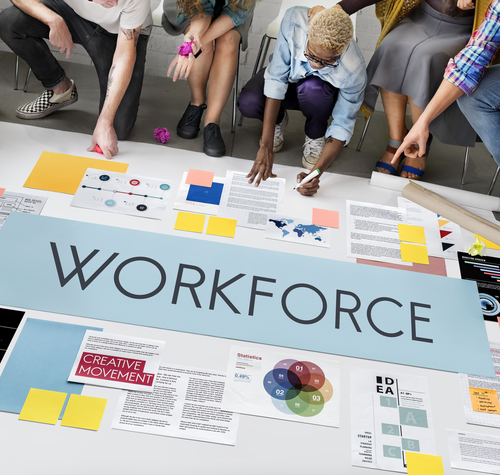Workforce planning is the process of building a robust organization through analyzing, forecasting, and determining workforce supply and demand, and it typically includes business plans for head count and finance. Good workforce planning also records skills and competencies to inform and maintain optimum resourcing and succession plans across all teams and locations as business needs change or fluctuate. Sometimes referred to as a systemic HR model, it combines recruiting, retention, reskilling, and job redesign in a continuous process.
For small companies, this can be done ad hoc in spreadsheets and e-mail whereby stakeholders within the company, such as managers or department heads, can request additional head count as their workload or responsibilities increase. In larger organizations—if a company opens new sites, goes through a merger or an acquisition, is publicly traded, or is planning for growth—HR and finance need a more streamlined, flexible, and intuitive process to align with their long-term corporate goals.
This approach provides a rich canvas of data-informed insights from which strategic business decisions can be confidently taken. This helps talent leaders make interventions that ensure a company has the right employees with the right expertise in the right place and, very importantly, at the right time. While the framework helps business leaders and people managers get the most out of their current workforce, it also plays a significant role when preparing for changes or bracing for the unknown.
Strategic Workforce Planning Is Especially Critical During Times of Change
Businesses are currently experiencing severe headwinds caused by uncertainties in the global economy. Inflation is rampant, unrest in Europe has stirred the global energy crisis, and the rising cost of living has put a dent in consumer and buyer confidence. Incorporating a workforce planning strategy enables companies to carefully respond to emerging economic or technological trends that influence when a company needs to grow or retrench employees.
A significant number of businesses have already responded to uncertainty with mass layoffs, but there’s one anomaly that hasn’t been seen in previous economic downturns: Labor is tight, and the vacancy rates are at an all-time high, making talent a very precious commodity. This is particularly significant because when this maelstrom ends—economists are predicting recovery to begin in 2024—if your business isn’t taking a strategic approach to best-practice workforce planning, it may survive the downturn, but it runs the risk of not being ready to catch the positive economic wave on the upturn. This will impact your farther down the line, especially without the right people in the right jobs at the right time. Contrary to popular belief, layoffs don’t usually reposition a firm toward growth because retrenching employees is only a short-term accounting solution. Additionally, a recent HiBob survey found that a shocking 40% of U.S. employees are worried about being let go in 2023.
The key to a thriving HR operation is flexibility. Companies are living and breathing entities with constantly evolving workforces and continuously changing needs. Whether you’re adding a new product line or service, expanding into new markets and geographies, scaling, or temporarily contracting, your company’s staffing needs will change. A strategic workforce planning framework will help you get the most out of your current workforce while preparing for what’s to come.
Supporting Positive Company Culture for Long-Term Success
There’s another benefit to consider here: Having a systemic approach to HR is also an ideal way to support a positive culture in which professionals can learn, grow, and progress.
If you move people from low-growth to high-growth areas for development and mobility, you create a culture of growth and learning and, in doing so, enter a cycle of continuously improved employee experience. The payback is increased productivity and retention. Getting the best from staff, reskilling, or developing them into new roles becomes more significant when you consider how frantic the search for top talent has become, especially if there’s a need to contract in one area and grow in another. Organizations can set themselves up for success by formulating an ever-ready strategy that supports today’s agile, people-focused, fluid workforce.
Being able to strategically select individuals from within an organization to fill roles has proven to create workforces made up of engaged employees who together contribute to a healthy and positive company culture. Cultivating a positive and productive environment in this way can have a transformational impact on a business and represents the perfect time to reassess what’s succeeding and where there’s room to grow.
People are always looking to invest in themselves, so if employers can back their staff through training, technology, and other means, they’ll be more likely to remain engaged and stay longer.
Workforce planning can seem like a daunting task, especially given the world’s unpredictability, but in times of uncertainty, strategizing and organizing for the future of your workforce is always a good idea.
Workforce planning is one of the most vital and time-consuming tasks culture leaders do. Success requires collaboration among all business leaders of an organization and a combination of transactional and strategic modes of thinking. When recruitment, employee development, talent management, and finance align with the company’s long-term objectives and goals, workforce planning can effectively drive the business forward.
Annie Rosencransis the Director of People and Culture at HiBob. She oversees all things HR for HiBob’s North American team while serving as a strategic business partner to the global sales function. Rosencransloves HR tech and has led people operations for several high-growth organizations, including New York-based start-ups Namely and Knotel. She also brings a breadth of experience across the HR field, focusing on HR transformation and change management.

